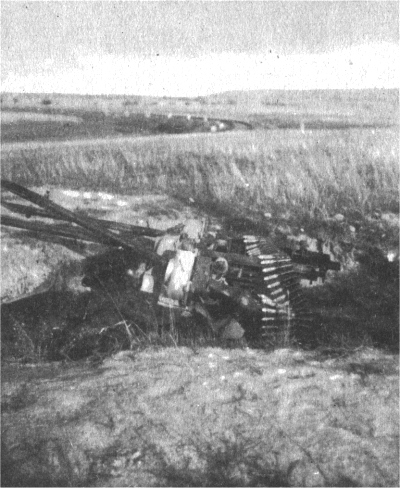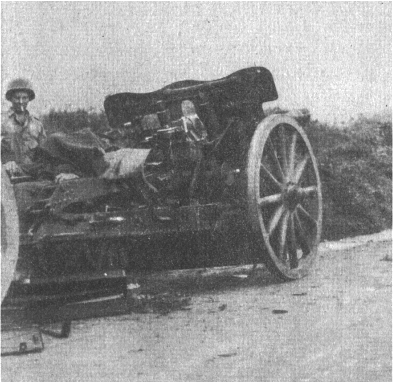|
|
| On the ninth day, the long, nervewracking vigil came to an end with the arrival of advance elements of the Eighth Infantry Division, whose appearance on the scene gave promise of rest for the weary soldiers, but even before relief had been completed the 50th Armored Infantry Battalion became a part of Task Force "B" along with elements of the Second Infantry Division whose mission was to clear the Daoulas Peninsula . . . at once. This stretch of territory was separated from the larger Brest Peninsula by the Landerneau River, and was defended by a strong enemy force. |

This multi-barreled 20 mm AA gun, a favorite German weapon, was frequently used against our advancing troops. This gun, firmly dug-in, was encountered along the Daoulas Peninsula, where its crew fled, leaving a belt of deadly cartridges looped over the weapon. |
|
Our Battalion had learned much from the experiences at Guipavas, and after encountering only light opposition during the first three days on the new mission, presently found itself within striking distance of Hill 63 which proved to be almost as well prepared against attack as had Hill 105. Studded with gun emplacements of all types it lacked but one element that set it apart from Hill 105, and that was in the quality of its troops. Perhaps *his [this] is an understatement, for they put up stubborn resistance against troops who were grimly determined that Hill 63 would not fall into our hands whatever the odds. At any rate, the enemy subjected our troops to as heavy fire as had previously been experienced, including fire from Coastal batteries located on the Crozon Peninsula. Despite this, Companies "A" and "B" pushed their attack along the North and South slopes of the hill, stopping but once when Company "B" was pinned down by heavy |

IMPOTENT When a German column crashed head-on into the 50th, just north of Bourg Blanc, Brittany, the result was as indicated by the above photo. The entire enemy column was battered into submission, and beside losing several field guns and other equipment, heavy casualties were inflicted in his ranks. |
|
machine gun fire. The delay was but temporary; Staff Sergeant Cybor, together with Private Hugh Cheshire, each wearing asbestos gloves, picked up light machine guns and, firing from the hip quickly routed the enemy gunners concealed by the thick hedgerows bordering the route of attack. "A" Company meanwhile opened a seven hundred yard gap on the left flank, and with troops deployed along the axis, turned the advance to the North. Then, in the wake of a deadly artillery barrage directed from an Observation Post held by Lieutenant Funnel, swept on up that hill, and with "B" Company, soon had overrun the Nazi positions.
With a degree of disorganization evident in the enemy ranks, our Battalion pushed on, and in rapid succession had occupied Hills 62 and 82, as well as the village of Lanrivoas. Strong enemy gun positions had been neutralized by the accurate fire of Headquarters Company Mortarmen, and on the evening of August 29, 1944, the entire Daoulas Peninsula had been entirely cleared of enemy troops by the 50th Armored Infantry Battalion. The objective thus achieved, our Battalion was now deployed along the Peninsula, prepared to thwart any attempt the enemy might make to break out of the Brest Fortress, that now was a prison for the Germans garrisoned within. With the fall of the great Nazi stronghold imminent, our Battalion prepared to move from its positions in the Daoulas area, which since its capture had permitted some degree of rest that had been well earned. Seasoned veterans of the once mighty Wehrmacht had wilted under the tremendous pressure of our troops who could boast of no more than five weeks of actual combat experience. The subsequent fall of Brest therefore will forever stand as a monument to the courage and determination of the men of our Battalion, whose sweep across the hedge-lined fields of northern Brittany had assured the doom of the French Port that had long served as Germany's greatest submarine base. Relieved on September 9, 1944 by the 35th Infantry Division, our Battalion formed in column once more to begin a long journey over French soil already liberated by other elements of the great American juggernaut that was relentlessly pounding the Nazis to bits. A great triumph had been achieved, our Battalion had been a prominent factor in every victory scored in the memorable Brittany Campaign, and though the Nazis had exacted a price in men and materiel [material], each victory had been quick and complete. And the men who fell in Britanny's fields surely did not die in vain, for in making the supreme sacrifice they contributed to the freedom of the entire world, the same precious freedom that they themselves demanded, for themselves, and for their own countrymen. When fire from a German "88" seriously hampered the Battalion's advance in the vicinity of Dinan, France on August 2, 1944, Captain Robert Haber, New York, Commanding "B" Company, personally led a Bazooka Team that destroyed the troublesome weapon. In order to reach the cleverly concealed German position, it was necessary to run and crawl across high ground under a hail of machine gun and mortar fire, a task that seemed almost impossible to achieve. For his part in this daring self-appointed Mission, Captain Haber was awarded the Silver Star, thus becoming the first of many members of the 50th Armored Infantry Battalion to distinguish themselves by gallantry in action against the enemy. By direction of the President, and under the provisions of Section One, Circular # 345, War Department dated 23 August 1944, the MERITORIOUS SERVICE UNIT PLAQUE, in recognition of superior performance of duty, outstanding devotion to duty in the performance of difficult tasks, and in recognition of achievement and maintenance of a high standard of discipline, is awarded to Service Company 50th Armored Infantry Battalion. |